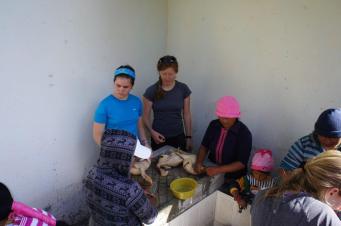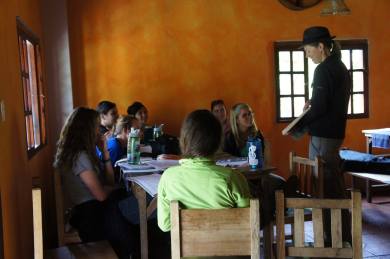Re-posted from the Tandana Blog
Written By: Alizah, New York, senior
February 20, 2014
February 20, 2014
The Traveling School arrived in Agualongo to greetings of “Feliz Dia de San Valentin” and Kichwa introductions from the community. In groups of three and four, we were paired up with the people who, over the next six days, would become our families.
After rolling out my sleeping bag on eye level with my host family’s pet guinea pigs, I joined my parents and five brothers at our “tulpa,” a small, separate room with a fire for cooking. I was amazed to find that every family member had a role in dinner preparation: the boys scrubbed dishes and collected kindling for the fire while my mom peeled entire potatoes with a single swipe. I tried (and failed) to imitate her “hand-as-cutting-board” technique with a bunch of scallions while ignoring every piece of culinary advice I had received over the past seventeen years. As the soup boiled between us – churning some roughly chopped scallions – smoke filled the small room. This gave way to our first family joke: “las gringas llorando” (foreigners crying).
We rose early the next morning for a community work party, or “minga.” Community members and students dispersed to gut chickens, peel potatoes, deepen an irrigation trench, tile the new community center, and prepare the soccer field for new lights that a former Traveling School student had fundraised for. After an exhausting and productive morning, we gathered for a traditional community lunch, which included blackberry juice, chicken soup, cuy (guinea pig) soup, and a customary mix of one dish contributed by each family. Following a series of “thank-you’s” from Tandana, community members, and students, we celebrated the morning’s hard work with an aftermath of volleyball, dance, and piggyback rides. Exhausted, and still digesting lunch, we returned home to prepare dinner. My eyes teared (a common theme, apparently) as I chopped onions one-on-one with my host-mom. For the first time of many, she told me how lucky she felt to have more daughters and how sad she was that we weren’t staying for a year, I was glad I had the onions to blame for my tears as I thought about how much love our families had to offer.
 The next morning, dressed in traditional Kichwa clothes, part of the group went to mass with their families while the rest of us stayed behind to bake bread. Five oven-loads later, we piled with our families into two busses, which took us to El Lechero, a sacred tree and prime picnic spot. We set out PBJs, cold-cuts, and fruit and the families once again each brought a dish to combine. One of the community members facilitated this custom, and then offered us a bowl to share. In return, we offered the community free reign of our supplies, resulting in some triple-decker PBJs filled with unspread globs of guanabana jelly. After a group clean-up effort, we continued on to El Parque Condor, a bird rehabilitation center, for a flight demonstration. The kids – and two sixteen year old Traveling School students – got to hold some birds afterwards. Three days later, my brothers were still running around flapping their arms and bird-calling. We returned around 6pm which presented me with my biggest challenge yet: trying to get my homework done while simultaneously entertaining my seven year old brother who loves ninjas, Jackie Chan, and my camera. For the first time since our arrival, I was able to keep my eyes open long enough to finish a journal entry (a feat I was proud of until I realized it was only 7:46pm).
The next morning, dressed in traditional Kichwa clothes, part of the group went to mass with their families while the rest of us stayed behind to bake bread. Five oven-loads later, we piled with our families into two busses, which took us to El Lechero, a sacred tree and prime picnic spot. We set out PBJs, cold-cuts, and fruit and the families once again each brought a dish to combine. One of the community members facilitated this custom, and then offered us a bowl to share. In return, we offered the community free reign of our supplies, resulting in some triple-decker PBJs filled with unspread globs of guanabana jelly. After a group clean-up effort, we continued on to El Parque Condor, a bird rehabilitation center, for a flight demonstration. The kids – and two sixteen year old Traveling School students – got to hold some birds afterwards. Three days later, my brothers were still running around flapping their arms and bird-calling. We returned around 6pm which presented me with my biggest challenge yet: trying to get my homework done while simultaneously entertaining my seven year old brother who loves ninjas, Jackie Chan, and my camera. For the first time since our arrival, I was able to keep my eyes open long enough to finish a journal entry (a feat I was proud of until I realized it was only 7:46pm).
Over the next few days, we experienced a traditional cooking class, Kichwa lessons, and a 94 year-old espanto (fright) healer (who “cured” one of our own). We spent a morning at a tree nursery weeding, taking down a decrepit greenhouse, and learning about a local cement factory’s impact on the environment and economy. That afternoon, we panted our way up a 90 degree incline interspersed with cows to a weather station where we learned about the different weather-measurement instruments and the observed impact of climate change on Ecuador’s weather patterns and agriculture. We spent a memorable evening teaching our families to make s’mores (proof of which remains in the form of marshmallow residue all over my pants).
Between classes, service, and play, I acclimated to the world of bucket-flush, was both scoffed and supported in my attempts to hand-wash laundry, ate more starches on my plate than I ever thought possible, and unsuccessfully insisted that chicken is not vegetarian. Six exhausting days later, I found myself in the Casa Comunal for the last time, saying “mis despedidas” to the people I had come to love. We each stood up and said an individual good-bye and thank you to our family, and then sang a song – complete with choreography – that we had written in Kichwa class to the community:
From far away I come (Karumanta Shamuni)
I come to get to know you (Riksinkapa Shamuni)
I come to work with you (Kankunawan llamkani)
I eat a lot (Ashtakata mikuni)
I love the food (Mikuykuta kuyani)
Now we are friends (Kunan mashimi Kanchik)
I thank you (Ninanta yupaychani)
I come to get to know you (Riksinkapa Shamuni)
I come to work with you (Kankunawan llamkani)
I eat a lot (Ashtakata mikuni)
I love the food (Mikuykuta kuyani)
Now we are friends (Kunan mashimi Kanchik)
I thank you (Ninanta yupaychani)


No comments:
Post a Comment